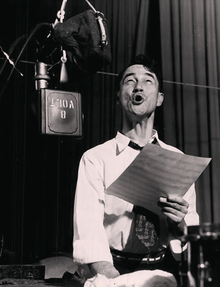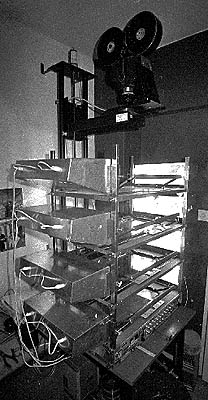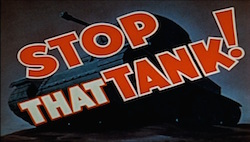
Walter Elias Disney was an American animator, film producer, voice actor, and entrepreneur. A pioneer of the American animation industry, he introduced several developments in the production of cartoons. As a film producer, he holds the record for most Academy Awards earned (22) and nominations (59) by an individual. He was presented with two Golden Globe Special Achievement Awards and an Emmy Award, among other honors. Several of his films are included in the National Film Registry by the Library of Congress and have also been named as some of the greatest films ever by the American Film Institute.

Goofy is a cartoon character created by the Walt Disney Company. He is a tall, anthropomorphic dog who typically wears a turtle neck and vest, with pants, shoes, white gloves, and a tall hat originally designed as a rumpled fedora. Goofy is a close friend of Mickey Mouse and Donald Duck, and is Max Goof's father. He is normally characterized as hopelessly clumsy and dim-witted, yet this interpretation is not always definitive; occasionally, Goofy is shown as intuitive and clever, albeit in his own unique, eccentric way.

Snow White and the Seven Dwarfs is a 1937 American animated musical fantasy film produced by Walt Disney Productions and released by RKO Radio Pictures. Based on the 1812 German fairy tale by the Brothers Grimm, the production was supervised by David Hand, and was directed by a team of sequence directors, including Perce Pearce, William Cottrell, Larry Morey, Wilfred Jackson, and Ben Sharpsteen. It is the first animated feature film produced in the United States and the first cel animated feature film.

Vance DeBar Colvig Sr., known professionally as Pinto Colvig, was an American voice actor, cartoonist, and circus and vaudeville performer whose schtick was playing the clarinet off-key while mugging. Colvig was the original performer of the Disney characters Goofy and Pluto, as well as Bozo the Clown and Bluto in Popeye. In 1993, he was posthumously made a Disney Legend for his contributions to Walt Disney Films, including Snow White and the Seven Dwarfs and Fun and Fancy Free.

The multiplane camera is a motion-picture camera that was used in the traditional animation process that moves a number of pieces of artwork past the camera at various speeds and at various distances from one another. This creates a sense of parallax or depth.

Myron "Grim" Natwick was an American artist, animator, and film director. Natwick is best known for drawing the Fleischer Studios' most popular character, Betty Boop.

Gabby is a short-lived Max Fleischer animated cartoon series distributed through Paramount Pictures. Gabby debuted as the town crier in the 1939 animated feature Gulliver’s Travels produced by Fleischer. Shortly afterward, Paramount and Fleischer gave Gabby his own Technicolor spinoff cartoon series, eight entries of which were produced between 1940 and 1941. Gabby was voiced by Pinto Colvig, the voice of Walt Disney's Goofy, Pluto, and Grumpy and Sleepy from Snow White and the Seven Dwarfs.

Gulliver's Travels is a 1939 American animated musical fantasy film produced by Max Fleischer and directed by Dave Fleischer for Fleischer Studios. Released to cinemas in the United States on December 22, 1939, by Paramount Pictures, the story is a very loose adaptation of Jonathan Swift's 1726 novel of the same name, specifically only the first part of four, which tells the story of Lilliput and Blefuscu, and centers around an explorer who helps a small kingdom who declared war after an argument over a wedding song. The film was Fleischer Studios' first feature-length animated film, as well as the second animated feature film produced by an American studio after Walt Disney Productions' Snow White and the Seven Dwarfs, as Paramount had commissioned the feature in response to the success of that film. The sequences for the film were directed by Seymour Kneitel, Willard Bowsky, Tom Palmer, Grim Natwick, William Henning, Roland Crandall, Thomas Johnson, Robert Leffingwell, Frank Kelling, Winfield Hoskins, and Orestes Calpini.

Kenneth B. "Ken" Anderson was an American animator, art director, and storyboard artist for The Walt Disney Company. He had been named by Walt Disney as his "jack of all trades".

The Reluctant Dragon is a 1941 American live-action/animated anthology comedy film produced by Walt Disney, directed by Alfred Werker, and released by RKO Radio Pictures on June 27, 1941. Essentially a tour of the then-new Walt Disney Studios facility in Burbank, California, the film stars Algonquin Round Table member, film actor, writer and comedian Robert Benchley and many Disney staffers such as Ward Kimball, Fred Moore, Norman Ferguson, Clarence Nash, and Walt Disney, all as themselves.

The Seven Dwarfs are fictional dwarfs in the 1812 fairy tale Snow White by the Brothers Grimm and other renditions and adaptations.
The second wave of Walt Disney Treasures was released December 3, 2002. This was the final wave with the tin's individual number embossed on the tin.
"The Silly Song", also known as "The Dwarfs' Yodel Song", is a song from Walt Disney's 1937 animated film Snow White and the Seven Dwarfs sung by Otis Harlan, Billy Gilbert, Pinto Colvig, Roy Atwell, and Scotty Mattraw. This features an instrument septet. The Seven Dwarfs yodel in this song. The melody is taken from the Irish folk song "Peggy Lettermore".

How to Hook Up Your Home Theater is a 2007 American animated comedy short film produced by Walt Disney Animation Studios, directed by Kevin Deters, and co-directed by Stevie Wermers-Skelton. It was the first theatrical Goofy solo cartoon short in since Goofy's Freeway Troubles (1965) 42 years earlier, and the first official short of the Goofy series since Aquamania (1961).

Playful Pluto (1934) is a Walt Disney cartoon, directed by Burt Gillett. It was the first cartoon to showcase Pluto as a major character. It was the 65th Mickey Mouse short film, and the third of that year.
Snow White is a Disney media franchise that began in 1937 with the theatrical release of Snow White and the Seven Dwarfs. It is based on the 1812 fairy tale by the Brothers Grimm.

Stop That Tank! is a 22-minute 1942 instructional film created during World War II by Walt Disney Productions for the Directorate of Military Training, The Department of National Defence and the National Film Board of Canada (NFB). Its purpose, akin to "edutainment", was to instruct Canadian soldiers in the handling and care of the Boys Mk.1 Anti-tank rifle for use in combat against Nazi tanks. The film presented information in an entertaining manner as well as providing an anti-Nazi propaganda message.

The Thrifty Pig is a four-minute educational short animated film made by Walt Disney Studios for the National Film Board of Canada. A World War II propaganda film, it was released theatrically on November 19, 1941, as part of a series of four films directed at the Canadian public to learn about war bonds. The Thrifty Pig was directed by Ford Beebe. It is also a remake of the 1933 film of the same name.

All Together is a three-minute educational short animated film made by the Walt Disney Studios, for the National Film Board of Canada. The film was released theatrically on January 13, 1942 as part of a series of four films directed at the Canadian public to buy war bonds during the Second World War.

Donald's Decision is a four-minute educational short animated film made by the Walt Disney Studios, for the National Film Board of Canada. The film was released theatrically on January 11, 1942 as part of a series of four films directed at the Canadian public to buy war bonds during the Second World War.


















